Please Take Note: This is a review of the game’s final prototype. The art, game bits, and the rules discussed are all subject to change. The game is being reviewed on the components and the rules provided with the understanding that “what you see is not what you might get” when the game is published. If you like what you read and want to learn more, we encourage you to visit the game’s web site or visit the Kickstarter campaign. Now that we have all that disclaimer junk out of the way, on with the review!
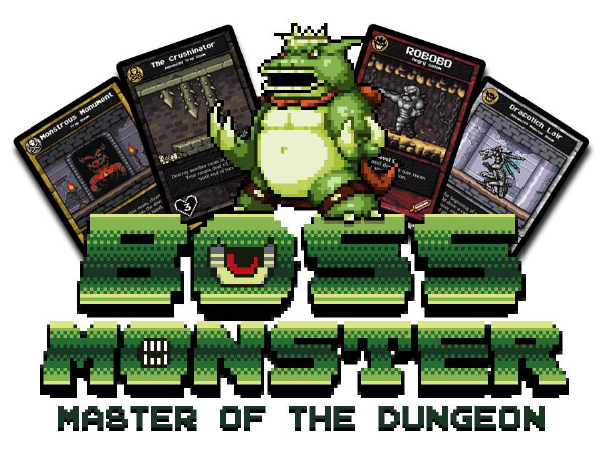
The Basics:
- For ages 8 and up (publisher suggests 13+)
- For 2 to 4 player
- Approximately 15 minutes to complete
Geek Skills:
- Counting & Math
- Logical & Critical Decision Making
- Reading
- Pattern/Color Matching
- Strategy & Tactics
- Risk vs. Reward
- Hand/Resource Management
Learning Curve:
- Child – Easy
- Adult – Easy
Theme & Narrative:
- Play as the biggest, the baddest, and the most powerful adversary of them all: The Final Boss Monster!
Endorsements:
- Gamer Geek approved!
- Parent Geek approved!
- Child Geek approved!
Purchase:
Overview
You have risen through the ranks, paid your dues, attended all the mandatory training meetings, and even did “extra work” for some of your superiors. Finally, you get the call. You are being given an opportunity to prove your worth as a Boss Monster. As quick as you can, you must create a dungeon to lure in heroes, collect their souls, and make sure your peers do not do better than you. After all, there can be only one final Boss Monster and the competition is downright fierce.
Boss Monster: Master of the Dungeon, by Brotherwise Games, is currently comprised of 75 Room cards, 25 Spell cards, 8 Boss cards, and 40 Hero cards. As this is a review of a prepublished game, we will not comment on the quality of the game components; however, the artwork is simply outstanding. Old school Nintendo Entertainment System (NES) like 8-bit graphics jump to life in various fantasy themed illustrations that depict monsters, heroes, and various dungeon rooms you most certainly don’t want to venture into. That would be enough to make many sit up and take notice, but the game designers went one step further and peppered the already very tasty cards with pop-culture goodness. Nods-o-plenty are given to influential and still very popular icons of geek culture. Metroid, the First Edition of Advanced Dungeons & Dragons Player’s Handbook, Castlevania, Double Dragon, and even Napoleon Dynamite’s legendary Liger, just to name a few. Looking through the cards is like taking a trip down Nostalgia Lane with smiles and old friends around every corner.
Dungeon Set Up
To set up the game, first separate all the cards into five different decks. These will be the Room, Boss, Heroes, Epic Heroes, and Spell decks. All the backs of the cards clearly show what the cards are and should make this a very easy and quick process.
Second, have each player draw a Boss card at random. Once drawn, the player places the Boss card in front of them, face-up. The remaining Boss cards are removed for the duration of the game.
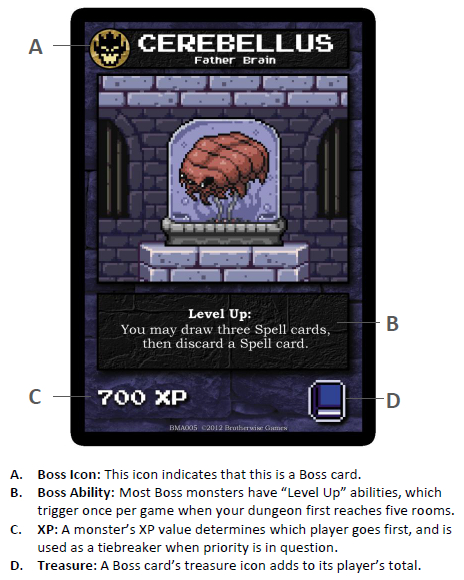
Third, shuffle the Room and Spell decks thoroughly and place the decks, face-down, to one side of the playing area. Leave enough room for a discard pile.
Fourth, look through the Hero and Epic Hero decks and remove the cards not available based on the number of players at the table. For example, if only playing with 2 players, all the 3-Player and 4-Player cards are removed from the game. There will be an icon at the bottom of the card to identify the number of players that must be at the table before the card can be used.
Fifth, shuffle the Hero and Epic Hero decks and then deal out a number of Hero and Epic Hero cards as the rules require based on the number of players at the table. Keep these two decks separate and face-down, placing them to the other side of the playing area, opposite of the Room and Spell decks. Any remaining Hero and Epic Hero cards that were not dealt to the table are removed for the duration of the game.
Sixth, have each player draw 5 Room and 2 Spell cards. The players can look at their hand, but should keep the cards hidden from their opponent’s at all times. From the 7 cards drawn, the player’s must select 2 to discard. To discard, the player selects the two they do not want and places them, face-down, in front of them. Once all the players have selected 2 cards to discard, they are collected and placed in the discard piles.
Seventh, each player will now select one of their Room cards and place it to the left of their Boss card. The Room card is placed on the table face-down and only revealed once all the players have placed their selected Room card down on the table, too. Any room can be built except Advanced Rooms (noted in the subtitle of the Room card). Take special note of the Room card’s description as there might be further restrictions. Room effects that are triggered when the Room card is revealed are resolved before continuing.
Once completed, the playing area will look something like the following image (2-player game set up shown).
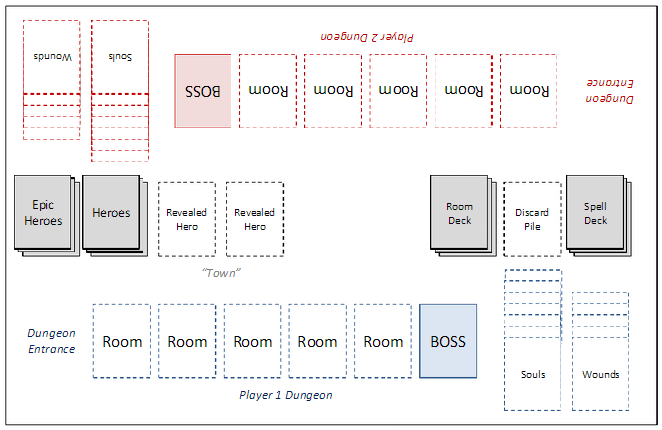
You are now ready to play! The player who has the Boss card worth the most XP goes first!
Open For Business
Note: I have been told the rules of the game are not yet finalized as the design team behind the game continues to tweak the rules to provide more detail and a cleaner game play experience. What is summarized here is based on the rule book and errata given to me. Visit the game’s web site or visit the Kickstarter campaign for the most up-to-date rules.
The game is played in turns with each turn further broken down into 5 phases. The phases are played in order and a turn does not end until all the players have been given an opportunity to complete each phase. The phases are summarized here.
Phase 1: Beginning of Turn
At the beginning of each turn, 1 Hero card per player is flipped over and added to what is referred to as the “Town”. Unless otherwise specified, draw and reveal all the Hero cards first before drawing any Epic Hero cards. Here the Heroes will wait until they hear rumors and legends of great treasure to be found in the players’ dungeons. At this time, each player will also draw 1 Room card and add it to their hand, starting with the First Player and going clockwise.
Phase 2: Build Phase
In his phase, all the players have an opportunity to build a room in their dungeon. How a player builds their dungeon and with what rooms will determine how important and lethal it is to Heroes. The majority of Room cards are considered “normal”, but there are “advanced” rooms that can be built on top of normal rooms if they share at least 1 treasure in common.
Rooms are independent of each other, but are all part of the player’s dungeon gauntlet. They do damage, provide cards, provide special effects, and create the foundation on which the player is attempting to achieve victory. Careful consideration should be taken before placing a room to ensure it compliments the dungeon’s growing ability to lure Heroes, destroy them, and collect points to win the game.
On the players turn, they will select one Room card and place it face-down. The player can also play any spell cards that have the “Hammer” icon during this phase as long as it is still the player’s turn. Once the player has revealed their Room card and played any Spell cards (before or after they reveal their Room card), their turn is over and the next player in turn order goes.
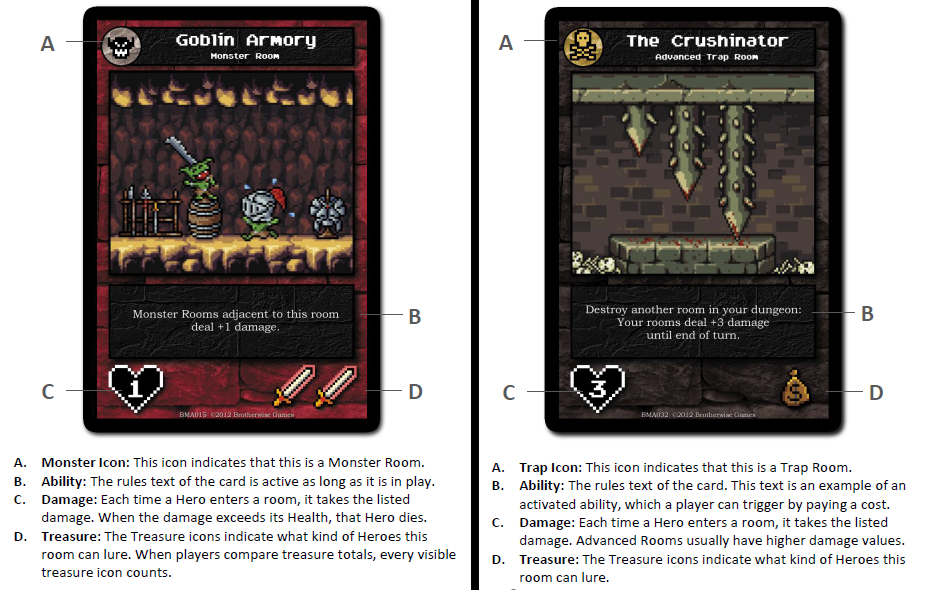
If a the player has 5 or more Room cards in a row, their Boss Monster might level up. This is a one time effect and the player resolves what the Level Up text on the Boss card states before continuing.
Phase 3: Bait the Heroes
Heroes will now flock to the dungeons the players built, but only to those that are rumored to have treasure the specific Hero is interested in. For example, fighter-class Heroes will naturally gravitate towards dungeons with magical weapons (sword icons), magic users will want arcane knowledge (book icons), and thieves will want riches (money bag icons). The Heroes that were revealed in the Town are now assigned to the dungeon with the MOST treasure icons that matches their desired treasure. If there is a tie, the Hero remains reluctant and stays in Town. For those who do make their way to a dungeon, they are placed to the far left of the left most dungeon Room card.
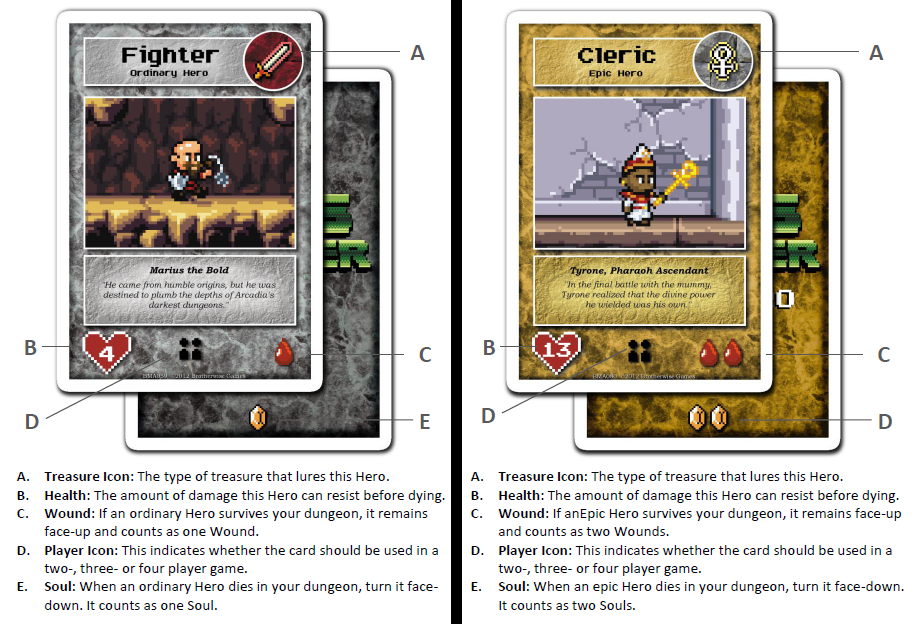
There is no limit to the number of Heroes that can be waiting in Town or enter into a dungeon. No spells or other magical tricks can be used by the players at this time to make the Heroes change their mind.
Phase 4: Adventure!
Starting with the First Player, each Hero will enter the dungeon they were lured to in hopes of finding treasure. This is done by the player selecting one of the Heroes outside the dungeon (in the order they arrived) and “walking” them through each room, one at a time. Players can play Spell cards and trigger room abilities during this phase to change how the rooms operate, but only if the Spell card has the “Axe” symbol.

Rooms damage a Hero as they venture through them. One of two things will happen while the Hero traverses the deadly dungeon gauntlet. They will either perish, having taken damage equal to or greater than their Health value or survive to reach the end Boss card. If the Hero perishes, they are flipped over and scored to the right of the Boss card as a “Soul”. If the Hero survives, they are also placed to the right of the Boss card, but are scored as a “Wound”.
This process is repeated for every Hero that is waiting outside the dungeon, one at a time, until all the players have completed this phase.
Phase 5: End of Turn
Once all the players have completed the previous 4 phases, all “until end of turn” effects are resolved, all deactivated rooms return to normal, and the endgame condition is checked. If the endgame has not yet been triggered, a new turn begins.
Dungeon Closure
The game can end one of two ways.
- The first player with 10 or more Souls and with less than 5 Wounds wins the game
- In a 2-player game, the first player with 5 or mores Wounds automatically gives the victory to their opponent
In a 3 or 4-player game, players who collect 5 Wounds before another player collects 10 Souls are out for the duration of the game. All ties are broken by looking at the Boss cards. The player with the lowest XP valued Boss Monster wins.
To learn more about Boss Monster: Master of the Dungeon and read the current rules, visit the game’s web site or visit the Kickstarter campaign.
Prediction
Boss Monster: Master of the Dungeon, just from reading the rules, would appear to be a very simple game. Simple enough to teach my 5-year-old, but the level of reading required is still too much for him to handle. A player must be able to read the cards, understand the icons and additional text, and then chose which card to play that will compliment the dungeon they have built so far. That sounds like a lot to manage, but not when we consider that the dungeon building itself is just adding to a series of rooms. A player is not building one big “machine”, but a series of machines, where each card can stand on its own. The end goal is to create a gauntlet that will chew-up and spit-out a hero. Simple, right? Well, not when we consider a few finer points about the game.
In addition to the cards doing damage to a Hero, they also have special effects that grant the owner abilities. A player can conceivably “combo” rooms by putting them in an order that would most benefit the player at the cost of a Hero’s life. We must also consider that a dungeon needs to draw in Heroes to be successful. This means a player must diversify their dungeon treasures to provide a lure juicy enough to draw in more than one Hero type every turn. When they do draw them in, the player must contend with a growing number of Heroes and their increasing level of strength, while at the same time managing the individual rooms as needed.
Yes, the more I think about this game, the more I am starting to see the level of detail a player must consider while building their Dungeon of Doom. Of course, a game reportedly only takes 15 minutes, so I wonder how “deep” a player really needs to delve to create their dungeon. I guess we’ll just have to see.
Teaching the game doesn’t take long as the different phases are rather straight forward, but the game rules are still in need of some tweaking. The players’ asked me several questions that were not specifically in the rules, but were implied in the game play. The game designers have already said they are still working on the rules, so I’ll reserve judgement on this point until they report they are done editing. Even so, the flow is easy enough to understand and all the players we tested the game with understood what was expected of them after only about 5 minutes of discussion.
And so, while I set the game up to play with my little geek, I asked him his thoughts on the game so far.
“Dad, this game looks so awesome! I’m going to build a huge dungeon that will DESTROY EVERYTHING!” ~ Liam (age 8)
At which point, he laughed evilly and shook his fist at the Heavens. He is clearly enthusiastic! Let’s put the game to the test and see if it allows for some epic dungeon runs or falls well short of the treasure room.
Final Word
Let’s first get a common assumption out-of-the-way, as it has come up often in our test groups. Boss Monster: Master of the Dungeon is nothing like Pixel Lincoln. Yes, they are both card games. Yes, they both use retro pop-culture video game illustrations in a way that redefines the universal definition of “awesome”. But that’s where the similarities end. An individual could own both of these games and play them without ever feeling a strong sense of Deja Vu or believing that they bought the same game twice. In other words, both games are unique.
OK, enough of that. Moving on…
My little geek loved the game. Loved it! What did he love about it? “Everything”, according to him. Of course, that won’t cut it for a game review. I had him narrow it down to 3. He gave me 4. First, he said he loved the illustrations. It reminded him of all the games he plays on his Nintendo DS (which he loves). Second, he really liked how all the rooms were different and never conflicted with each other. This made it easy and fun to create the dungeon by adding rooms without worrying how they would interact. Third, he really enjoyed the different Heroes that came through and watching them try to navigate his dungeon. He jumped up with joy when they perished and growled in frustration when they made it through alive. Fourth, he liked how fast the game was played. Less downtime means more fun time. All the other Child Geeks we played the game with also enjoyed it for the same or slightly different reasons. Regardless, all very positive and well received.
Parent Geeks also really enjoyed the game. They found it to be fast, fun, casual, and a good game to play with the family. The Parent Geeks also enjoyed how much they were able to talk about video games with their little geeks and discuss what some of the illustrations could be. For example, one Parent Geek and his little geeks talked on and on about Mother Brain from Metroid while they were playing because the Parent Geek was using with the Boss card “Cerebellus”. They geeked out at the table, both with the game and talking about video games, making the entire game play experience very enjoyable. Non-gamers also had an easy time playing and enjoying Boss Monster: Master of the Dungeon. Visually, the cards and the progression of the Heroes through the dungeon rooms is satisfying and there was never any confusion about what to do next. One specific game mechanism that did bother all the players was the difficulty of drawing Spell cards. Some players were never able to get a dungeon gauntlet going fast enough to provide the cards they wanted. This frustrated some and inspired others to simply build a “better dungeon” next time they played.
Gamer Geeks were gushing with nostalgia with this game and very much enjoyed the casual game play. They thought the game had just enough depth to provide for light strategy and tactics, and the game play was quick. They had the most fun building their dungeon and seeing how fast they could lure in Heroes and kill them off 2 or 3 at a time. The Gamer Geeks also saw how difficult it could be to create a truly “optimal dungeon” that would eat everything and anything you threw at it. This was a challenge they greatly enjoyed. What they wanted, and the game does not currently provide, is more player interrupt actions. The Gamer Geeks wanted an opportunity to mess with the other player’s dungeons out-of turn, but everyone agreed that having the ability to do so would probably lengthen the play time without really adding more to the game.
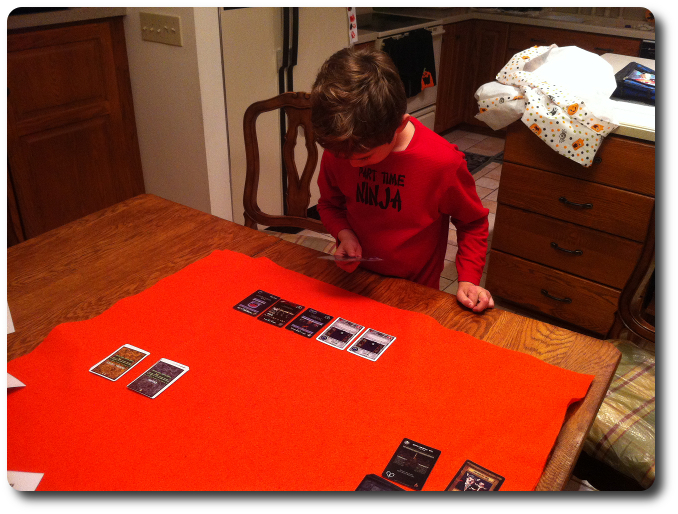
My little geek carefully considers which Room card to play on his ever-expanding dungeon of awesomeness
Gamer Geeks, this is a casual game of light strategy and tactics, where you will be building your dungeons that focus on two crucial aspect. These are lurability and timing. The first, lurability, determines the Heroes you can bring into your dungeon. If you specialize (only drawing in Fighters, for example), you will certainly win their interest, but will lock yourself out from every other Hero who ventures into Town. You’ll need to make sure your dungeon is suitably interesting to more than one Hero to stay competitive. The second, timing, is all about how you place your rooms and play your Spell cards. If you put rooms that give you bonuses towards the end and lots of other rooms ahead of it, you might not ever have a Hero survive long enough to trigger the Room card effect. Likewise, you’ll want to make sure a Hero never survives your dungeon or all that planning will be for nothing. This makes for some very interesting building decisions, and with the use of some Spell cards that can “freeze” a room, you have the ability to turn a room “off” temporarily. In the end, your peer group highly enjoyed the game, found it to be perfect for game nights, and quick game sessions.
Parent Geeks, your peer group also very much enjoyed the game and liked the variety of rooms and ways players could build their dungeons. It was the dungeon building aspect that was the most enjoyed. All the players loved the challenge of creating a dungeon better than their opponent and enticing as many Heroes as they could. The game played well with your peers, with non-gamers, and with families. The 4-player game takes longer, naturally, than the 2-player game, but is also a lot more competitive. Win or lose, you’ll find yourself eagerly rooting for the bad guy in the game, which also happens to be you.
Child Geeks, this game was a great treat for your peer group. Several comments from your peers suggested that Boss Monster: Master of the Dungeon felt like a “video game” and a few of your group were very displeased that it wasn’t. Where the game really tickled your fancy was the many different ways you could build your dungeons. Despite not being able to win every game, there was never a player who didn’t walk away from the table with a smile. How you build your “perfect dungeon” is totally up to you, which is a lot of fun. Do expect to play this game often if you get your hands on it.
Boss Monster: Master of the Dungeon plays very well with different skill levels and does not punish a player for failing to make an efficient dungeon. A player can simply add Room card after Room card and still draw in Heroes, but a player who carefully plans their dungeon layout, considers the timing of each card, and how they leverage the Spell cards, will find that they not only collect Hero souls, but will also have more opportunities. This is perhaps one of the greatest strengths of the game. It is free-form in regards to dungeon building, but it becomes clear that logic and reason in the design makes for a better game for the player. While an individual will simply not have the time to create the “best dungeon in the world”, the challenge comes in creating a dungeon that gets down to business, nukes the Heroes, and provides additional returns to its owning player. It is obvious when a player has built a truly wonderful dungeon, but even the bad ones still draw in Heroes.
I personally find this game to be wonderful and brilliantly thought out. The game is fast, fun, and unrestrictive, but challenges a player to be thoughtful, careful, and efficient to a level that best matches their ability and understanding of the game. I saw Child Geeks, Parent Geeks, and Gamer Geeks each explore different levels and depths of the game, and each found something unique and entertaining. The game is also very reminiscent of the classic PC game, Dungeon Keeper. In fact, I’d say this game captures everything I loved about the computer game, but is much easier to play and takes a lot less time. Very satisfying.
If you are looking for an easy to teach and easy to learn dungeon building game, where the players must architect a gauntlet with emphasis on optimisation in as little time as possible without feeling stressful, then put on your hardhat and grab a copy of Boss Monster: Master of the Dungeon. You will not regret it.
This game was given to Father Geek as a review copy. Father Geek was not paid, bribed, wined, dined, or threatened in vain hopes of influencing this review. Such is the statuesque and legendary integrity of Father Geek.



